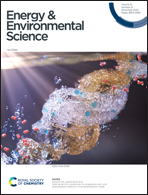Direct Z-scheme polymeric heterojunction boosts photocatalytic hydrogen production via a rebuilt extended π-delocalized network†
Abstract
Carrier recombination involved in polymeric photocatalysts includes undissociated exciton decay and charge recombination, which are the major hindrance limiting their photocatalytic activities. Realizing highly efficient charge generation and separation simultaneously in one polymeric system is therefore a fundamental strategy for the potential success of solar-to-hydrogen conversion but remains a great challenge. Here, we develop a large π-delocalized direct Z-scheme polymeric heterostructure (g-C3N4/P1Cl-T) that synergistically integrates a two-dimensional (2D) donor–acceptor conjugated polymer (P1Cl-T) with g-C3N4. We demonstrate that the intermolecular π–π stacking successfully rebuilds the extended π-network over the whole polymeric heterojunction, thus facilitating full-visible-light absorption, exciton dissociation and charge transport. The combination of spectroscopic analysis and theoretical calculations reveals that both resonance energy transfer and Z-scheme charge transfer occur upon light illumination. With the intense synergy among the large π-delocalization, π–π stacking interactions and internal electric field, the g-C3N4/P1Cl-T photocatalyst shows an unprecedentedly high hydrogen evolution rate of ∼111.8 mmol h−1 g−1 with apparent quantum yields (AQYs) of 46.75% at 475 nm and 1.77% at 700 nm, which is about 48-fold higher than that of pristine g-C3N4 and tops those for all the previously reported polymer-based photocatalysts.



 Please wait while we load your content...
Please wait while we load your content...